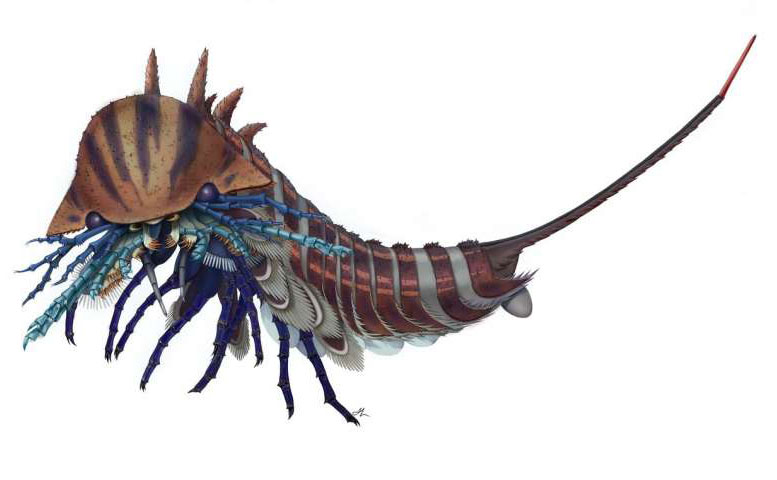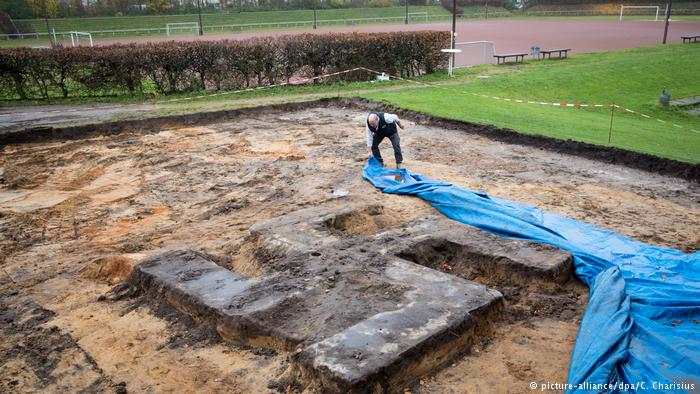
A small creature, smaller than an inch in length, that lived about 508 million years ago was, despite its small size, likely a fierce predator on the seafloor during the middle Cambrian Period. This conclusion by scientists was based on the design of the creature’s head, which was very sophisticated.
Habelia optata – two centimetres long and first discovered a century ago – is described in detail for the first time in the journal BMC Evolutionary Biology.
The description, led by Cédric Aria of the University of Toronto, reveals a savage hunter that walked in the waters of the Burgess Shale around 500 million years ago. Although very distantly related to modern horseshoe crabs and scorpions, Habelia shows structural adaptations that suggest its behaviours were rather more similar to those of a very different arthropod group, known as mandibulates.
The Burgess Shale is a fossil-bearing deposit in the Canadian Rockies. It was first discovered in 1909 and quickly came to prominence among palaeontologists because it contained an abundance of soft-bodied creatures from the Middle Cambrian period.
Called “the most precious and important of all fossil localities” by the late palaeontologist Stephen Jay Gould, the fossil bed not only produced many species previously unknown, but entirely new phyla.
The animals are mostly very small but represent evolutionary branches that seem to defy many of the common principles that are strongly conserved in today’s extant species. There are animals with five eyes, for instance, or seven pairs of stilt-like legs. Then there is a half-metre-long shrimp-like animal, and Pikaia, a tiny fluke-like thing that had a primitive spinal cord, easily the earliest known representative of the phylum that today contains our own species.
And now there is Habelia optata, a vicious little beast covered in spines, with a thorax boasting five pairs of legs and a post-thorax, or tail, covered in rounded appendages probably used in respiration.
Habelia’s head, however, is the really interesting bit. It features a complex admixture of five sets of appendages, including large plates covered in teeth, pseudo-legs covered in bristly spines, long slender branches likely to have been used to feel or sense food, and a pair of appendages towards the pack of the head thought to have been used to assist the other bits in funnelling food towards the tooth-covered business end.
“This complex apparatus of appendages and jaws made Habelia an exceptionally fierce predator for its size,” says Aria. “It was likely both very mobile and efficient in tearing apart its prey.”
To arthropod experts, the layout of Habelia’s head, while weird in itself, is not hugely unusual. Indeed, earlier analysis of specimens led to an initial (albeit cautious) classification of the creature as a member of the mandibulate group.
This is a subphyla – extremely diverse today – of arthropods that possess antennae and a pair of organs, dubbed mandibles, used for grasping, scissoring and crushing food. Modern mandibulates include grasshoppers, cockroaches and centipedes.
Aria and co-researcher Jean-Bernard Caron analysed 41 Habelia specimens – some newly acquired from the Burgess Shale – and came to a different conclusion.
Meticulous observation of the creature’s head structure revealed it to be a member of a completely different subphyla, called the chelicerates. These are so named because of the tell-tale presence of a pair of specialised appendages (called chelicerae) in the front of the mouth. Modern chelicerates include horseshoe crabs and arachnids.
Aria and Caron believe that Habelia evolved in such a way that its body parts became adapted for use in ways that mirrored those of mandibulates – a process known as convergent evolution.
“From an evolutionary point of view, Habelia is close to the point of divergence between chelicerates and mandibulates,” says Aria.
“But its similarities with mandibulates are secondary modifications of features that were in part already chelicerate in nature. This suggests that chelicerates originated from species with a high structural variability.”
The researchers suggest that the species was an active predator, stalking the Cambrian sea floor in search of prey species. Its most likely targets, they suggest, were trilobites – small creatures covered in tough shell carapaces.
“This builds onto the importance of carapaces and shells for evolutionary change during the Cambrian explosion, and expands our understanding of ecosystems at this time, showing another level of predator-prey relationship and its determining impact on the rise of arthropods as we know them today,” says Caron.













